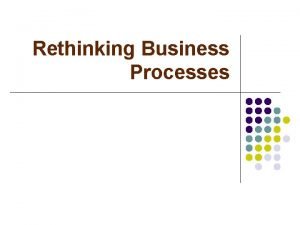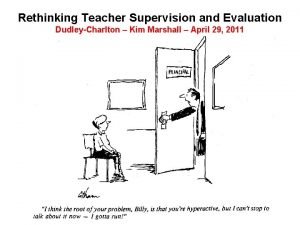Rethinking the Uninsured Greg Scandlen Rethinking the Uninsured

















- Slides: 17

Rethinking the Uninsured Greg Scandlen

Rethinking the Uninsured We’ve been working on this issue since I first got into this business -- 30 years ago. n n n Medicaid Expansions SCHIP High Risk Pools Small Group and Individual Market Reforms COBRA, HIPAA Cost control Nothing we’ve tried has solved anything. Sometimes when a problem seems intractable, it is time to reframe the issue.


Insured versus Uninsured -False Dichotomy This conference has added “the underinsured. ” • • Why not “the over-insured? ” Why not “the well-insured who can’t get services? ” Why not “the well-insured for 8 months a year? ” Why not “the uninsured who are eligible for Medicaid and can be instantly enrolled when something serious happens? ” Is insurance really the point, or should it be accessing and paying for health care services?

Counting the Uninsured (percent of non-elderly population) 1998 Uninsured all year SIPP 9. 1 MEPS 13. 3 Uninsured at any time during year SIPP 24. 5 MEPS 25. 3 Uninsured at a point in time SIPP 16. 6 MEPS 18. 3 NHIS 16. 5 CPS 18. 4 (Source: Congressional Budget Office, May, 2003) 1999 n/a 12. 2 n/a 25. 1 15. 7 17. 4 16. 0 16. 2

Counting the Uninsured Percent insured versus uninsured, 1987 - 2005 SOURCE: US Census Bureau, http: //www. census. gov/hhes/www/hlthins/hihistt 4. html

Counting the Uninsured In fact, virtually everyone is insured for something, and no one is insured for everything. n Young males, age 21 - 24 are the least likely to have health insurance of any age/gender category (40. 7% were uninsured in 2004). n But even they are usually covered for the things most likely to happen to them - auto accidents and workplace injuries. n Are they really “uninsured? ” n At the same time, people who are considered “fully insured” are not covered for everything. n People on Medicare on average spend 21. 7% of their income on OOP services, according to Karen Davis, or 15. % as a median according to Patricia Neuman. Which group is better insured?

Defining the Underinsured Probably the most common definition is 10% of income spent on health care. n n n But why, when national spending is 16%? Why is it bad to spend 10%+ on directly on health care, but not bad to spend 10%+ on taxes that pay for health care? If 10% is the standard, then Medicare is terrible. According to Banthin and Bernard in JAMA: n 19. 4% of Medicaid and SCHIP spent 10%+ n 18. 2% of privately insured n But only 10. 5% of the uninsured do Is it best to be uninsured?

Defining the Underinsured Where Does the Family Budget Go? 1918 1961 1987 Food 41. 1% 26. 0% 19. 4% Housing 26. 8 29. 2 33. 7 Transportation 3. 1 15. 1 25. 7 Clothing 17. 6 10. 3 5. 2 Health Care 4. 7 6. 6 4. 0 Other 6. 7 12. 8 12. 0

Sources of HC Spending

Rethinking the Issue Considerations in Expanding Coverage: n Who decides what to cover -- insurance companies, employers, the government -- or consumers? n Adverse Selection versus Moral Hazard n Insurance versus Third-Party Payment n Risk Pooling versus Pre-Paid Health Care n Pre-paid Health Care versus Post-paid Health Care n Premiums versus Benefits

Third Party Payment Insurer Consumer Provider

Two-Party Contracts Provider Insurer Consumer Employer

Risk Pooling Source: World Bank, 2004: http: //extsearch. worldbank. org/servlet/Site. Search. Servlet? q=risk%20 pooling

Employer-Based Tax Subsidy, by Household Income, 2004

How Much Change is Needed?

Contact: Greg Scandlen Consumers for Health Care Choices www. CHCChoices. org 301 -606 -7364 Greg@CHCChoices. org
 Rethinking the value of network pruning
Rethinking the value of network pruning Rethinking business process
Rethinking business process Rethinking education: towards a global common good?
Rethinking education: towards a global common good? Rethinking file mapping for persistent memory
Rethinking file mapping for persistent memory What is cdio
What is cdio Rethinking teacher supervision and evaluation
Rethinking teacher supervision and evaluation What is the fundamental rethinking of business processes
What is the fundamental rethinking of business processes Rethinking the 4 p's
Rethinking the 4 p's Rethinking file mapping for persistent memory
Rethinking file mapping for persistent memory Ubígua
Ubígua Gấu đi như thế nào
Gấu đi như thế nào Thẻ vin
Thẻ vin Thể thơ truyền thống
Thể thơ truyền thống Các châu lục và đại dương trên thế giới
Các châu lục và đại dương trên thế giới Từ ngữ thể hiện lòng nhân hậu
Từ ngữ thể hiện lòng nhân hậu Diễn thế sinh thái là
Diễn thế sinh thái là Thế nào là giọng cùng tên
Thế nào là giọng cùng tên Ng-html
Ng-html

































